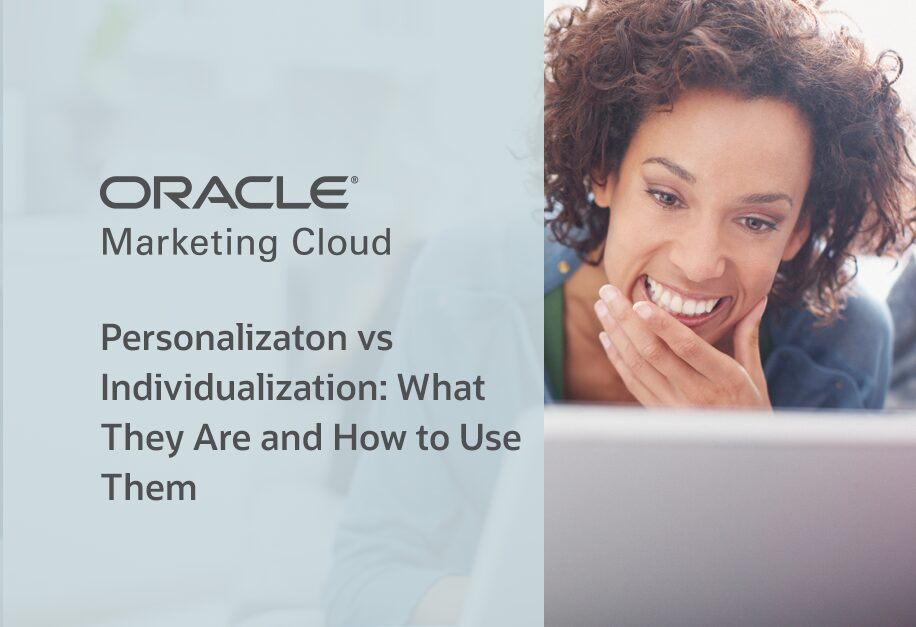
Every marketing article seems to include “personalization” as a critical strategy (and a key challenge), especially when talking about email marketing and ABM. It’s often a term that becomes interchangeable with other concepts, such as segmentation. Now, there’s another word to include in the marketing mix: individualization.
No matter who your audience is, personalization and individualization play a role in your strategic marketing. Although the terms sound like they’re interchangeable, there are differences in what they mean and how you’ll incorporate them.
Personalization
Let’s start with the term you hear most often in today’s marketing conversations: personalization. Personalization addresses your audience’s personal needs and interests. The process involves the audience’s active participation in sharing this information with you.
But personalization in marketing can mean as little as adding a prospect’s or customer’s first name to each email that’s sent as part of a campaign. Other filters increase personalization beyond the name, such as including information on a birthday, past purchases, or product interests.
In some ways, this description makes personalized marketing seem outdated. Yet it’s still a necessary and valuable technique for initially connecting with your targets.
Individualization
Individualization goes even deeper into the process of acknowledging differences. You’re no longer talking to the “us” in the audience; it’s about all the “me.”
With the changed focus, individual needs that make one customer or prospect different from another become the defining concepts for messaging and campaigns. Compared to personalization, where a company focuses on some areas of common ground between its audience members, this approach acknowledges the attributes and interests that make each consumer unique.
In reality, today’s audiences seek brands that deliver this level of contact and understanding about them. Although they enjoy the convenience of the online environment, consumers like the idea that a company knows them individually, beyond basic details added to a database. While you can start a customer relationship with personalization, it needs to evolve by leveraging individualization techniques.
Marketing Tools and Strategies for Personalization and Individualization
If it weren’t for technology, both approaches to marketing would be impossible. That’s because there are too many prospects and customers to deliver such detailed approaches.
But marketing technology — like automation platforms — offers an invaluable resource for increasing personalization within marketing campaigns. The main difference, however, is that technology for personalized marketing still relies somewhat on a mass-marketing approach for delivering content and campaigns. In contrast, technology that powers individualized marketing approaches requires a data-driven strategy.
Both Approaches Require Full Data
Although there are differences between personalization and individualization, a company needs to incorporate both approaches in its marketing strategy. Also, these marketing techniques also demand access to complete data.
Your first step involves collecting a complete data set with enough points to understand individual needs and preferences. To do so means gathering data across channels — email, social, phone calls, and web visits — and culling dynamic content like comments and online conversations for further insights. Internet of Things (IoT) devices are one type of technology enabling a better understanding of individual behaviors and preferences.
Once you’ve got the data to produce personalized interactions and individualized marketing campaigns, the next step is to apply data-driven analytics that help identify the most important data points to use. Adding these data points to technology-driven marketing platforms can produce relevant content for each person’s needs.
Challenges Remain, Despite Tech Support
Technology has helped marketers come a long way in their efforts to acknowledge each audience member as unique. But audiences themselves don’t make it any easier. When it comes to determining how to deliver this individualized interaction, your audience continues to shift between places, devices, and time.
These challenges illustrate the reason for migrating from personalization to individualization. As prospects convert to customers, data collection must expand to track and record the shifts in place, device, and time. As a result, you’ll be able to further individualize your interaction efforts.
Technology, once again, can jump in to assist you via machine learning and artificial intelligence. This technology continually assesses these shifts and acts on your behalf through automated responses. With individualized marketing campaigns, technology can help you by creating the messages and the visuals in the moment of interest for each audience member.
Imagine the opportunities that await when you reach your targets where they are while acknowledging who they are. Customers expect a deeper relationship — and that’s exactly how you’ll build loyalty and your bottom line.
Data factors heavily into both personalization and individualization. It is how you put your data into action. Learn more about how with “A New Breed of Analytics: Put Data in Motion.”
